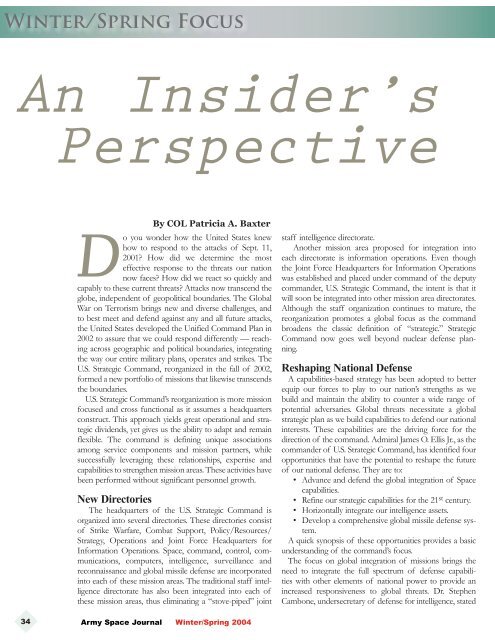Volume 3, Number 1 - Space and Missile Defense Command - U.S. ...
Volume 3, Number 1 - Space and Missile Defense Command - U.S. ...
Volume 3, Number 1 - Space and Missile Defense Command - U.S. ...
Create successful ePaper yourself
Turn your PDF publications into a flip-book with our unique Google optimized e-Paper software.
An Insider’s<br />
Perspective<br />
By COL Patricia A. Baxter<br />
Do you wonder how the United States knew<br />
how to respond to the attacks of Sept. 11,<br />
2001? How did we determine the most<br />
effective response to the threats our nation<br />
now faces? How did we react so quickly <strong>and</strong><br />
capably to these current threats? Attacks now transcend the<br />
globe, independent of geopolitical boundaries. The Global<br />
War on Terrorism brings new <strong>and</strong> diverse challenges, <strong>and</strong><br />
to best meet <strong>and</strong> defend against any <strong>and</strong> all future attacks,<br />
the United States developed the Unified Comm<strong>and</strong> Plan in<br />
2002 to assure that we could respond differently — reaching<br />
across geographic <strong>and</strong> political boundaries, integrating<br />
the way our entire military plans, operates <strong>and</strong> strikes. The<br />
U.S. Strategic Comm<strong>and</strong>, reorganized in the fall of 2002,<br />
formed a new portfolio of missions that likewise transcends<br />
the boundaries.<br />
U.S. Strategic Comm<strong>and</strong>’s reorganization is more mission<br />
focused <strong>and</strong> cross functional as it assumes a headquarters<br />
construct. This approach yields great operational <strong>and</strong> strategic<br />
dividends, yet gives us the ability to adapt <strong>and</strong> remain<br />
flexible. The comm<strong>and</strong> is defining unique associations<br />
among service components <strong>and</strong> mission partners, while<br />
successfully leveraging these relationships, expertise <strong>and</strong><br />
capabilities to strengthen mission areas. These activities have<br />
been performed without significant personnel growth.<br />
New Directories<br />
The headquarters of the U.S. Strategic Comm<strong>and</strong> is<br />
organized into several directories. These directories consist<br />
of Strike Warfare, Combat Support, Policy/Resources/<br />
Strategy, Operations <strong>and</strong> Joint Force Headquarters for<br />
Information Operations. <strong>Space</strong>, comm<strong>and</strong>, control, communications,<br />
computers, intelligence, surveillance <strong>and</strong><br />
reconnaissance <strong>and</strong> global missile defense are incorporated<br />
into each of these mission areas. The traditional staff intelligence<br />
directorate has also been integrated into each of<br />
these mission areas, thus eliminating a “stove-piped” joint<br />
staff intelligence directorate.<br />
Another mission area proposed for integration into<br />
each directorate is information operations. Even though<br />
the Joint Force Headquarters for Information Operations<br />
was established <strong>and</strong> placed under comm<strong>and</strong> of the deputy<br />
comm<strong>and</strong>er, U.S. Strategic Comm<strong>and</strong>, the intent is that it<br />
will soon be integrated into other mission area directorates.<br />
Although the staff organization continues to mature, the<br />
reorganization promotes a global focus as the comm<strong>and</strong><br />
broadens the classic definition of “strategic.” Strategic<br />
Comm<strong>and</strong> now goes well beyond nuclear defense planning.<br />
Reshaping National <strong>Defense</strong><br />
A capabilities-based strategy has been adopted to better<br />
equip our forces to play to our nation’s strengths as we<br />
build <strong>and</strong> maintain the ability to counter a wide range of<br />
potential adversaries. Global threats necessitate a global<br />
strategic plan as we build capabilities to defend our national<br />
interests. These capabilities are the driving force for the<br />
direction of the comm<strong>and</strong>. Admiral James O. Ellis Jr., as the<br />
comm<strong>and</strong>er of U.S. Strategic Comm<strong>and</strong>, has identified four<br />
opportunities that have the potential to reshape the future<br />
of our national defense. They are to:<br />
• Advance <strong>and</strong> defend the global integration of <strong>Space</strong><br />
capabilities.<br />
• Refine our strategic capabilities for the 21 st century.<br />
• Horizontally integrate our intelligence assets.<br />
• Develop a comprehensive global missile defense system.<br />
A quick synopsis of these opportunities provides a basic<br />
underst<strong>and</strong>ing of the comm<strong>and</strong>’s focus.<br />
The focus on global integration of missions brings the<br />
need to integrate the full spectrum of defense capabilities<br />
with other elements of national power to provide an<br />
increased responsiveness to global threats. Dr. Stephen<br />
Cambone, undersecretary of defense for intelligence, stated<br />
34<br />
Army <strong>Space</strong> Journal Winter/Spring 2004

















